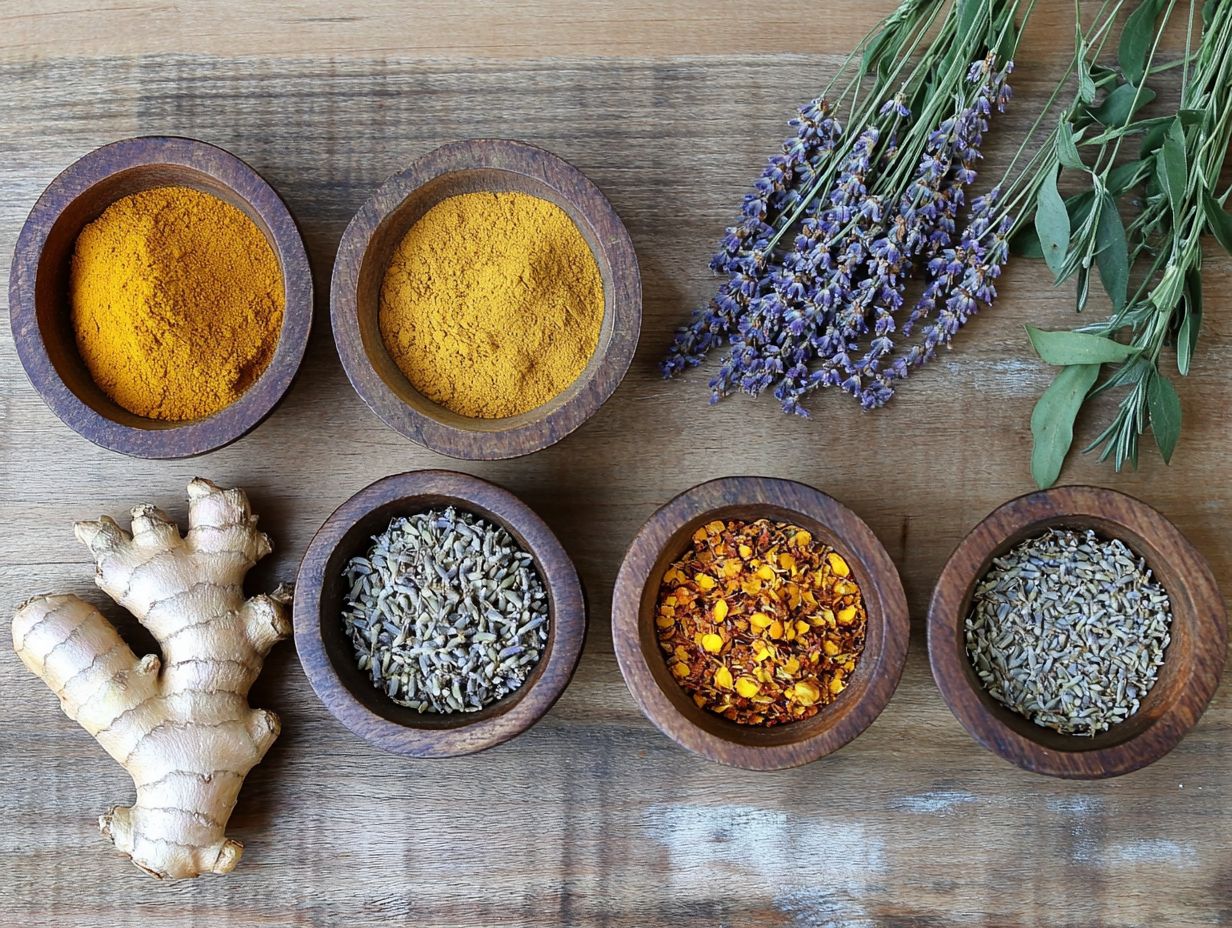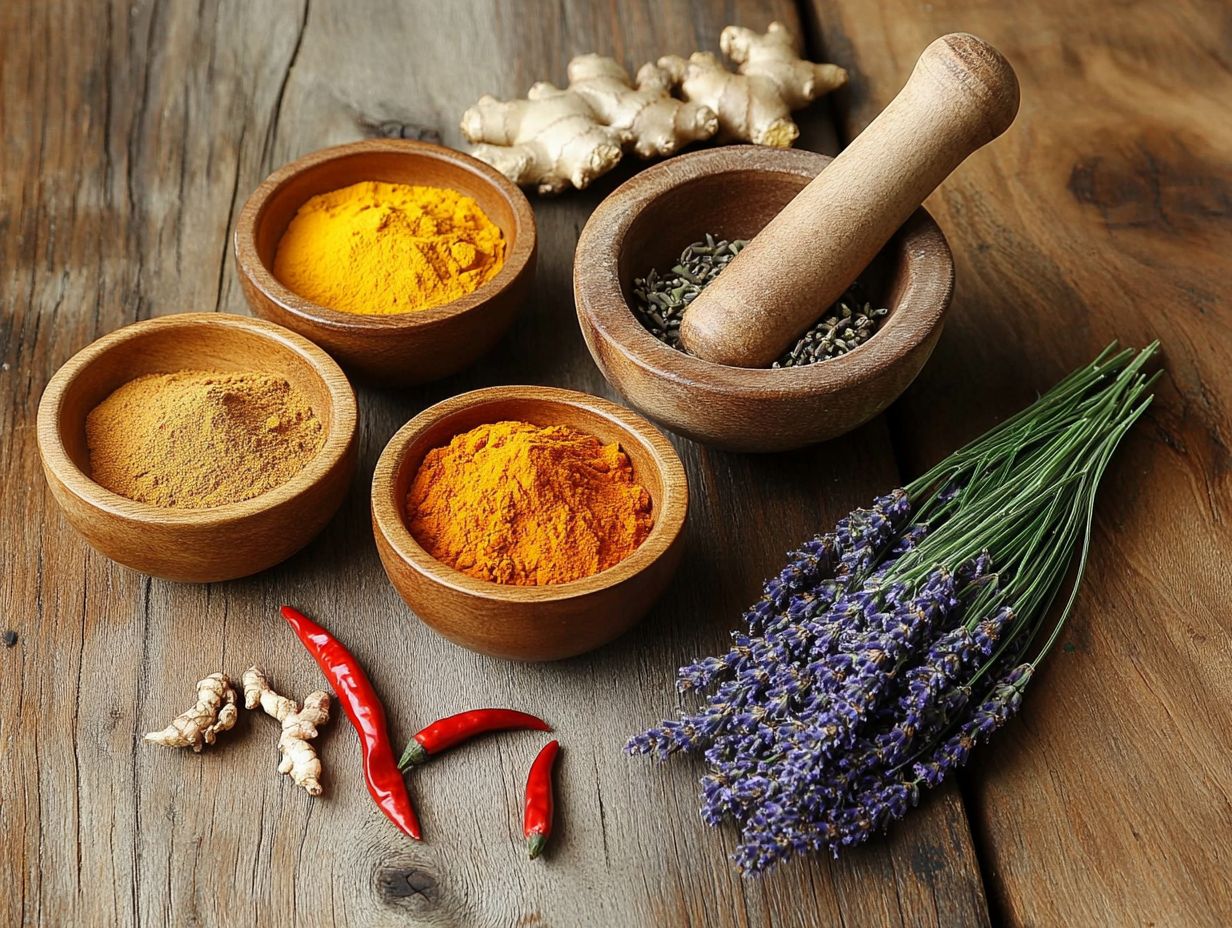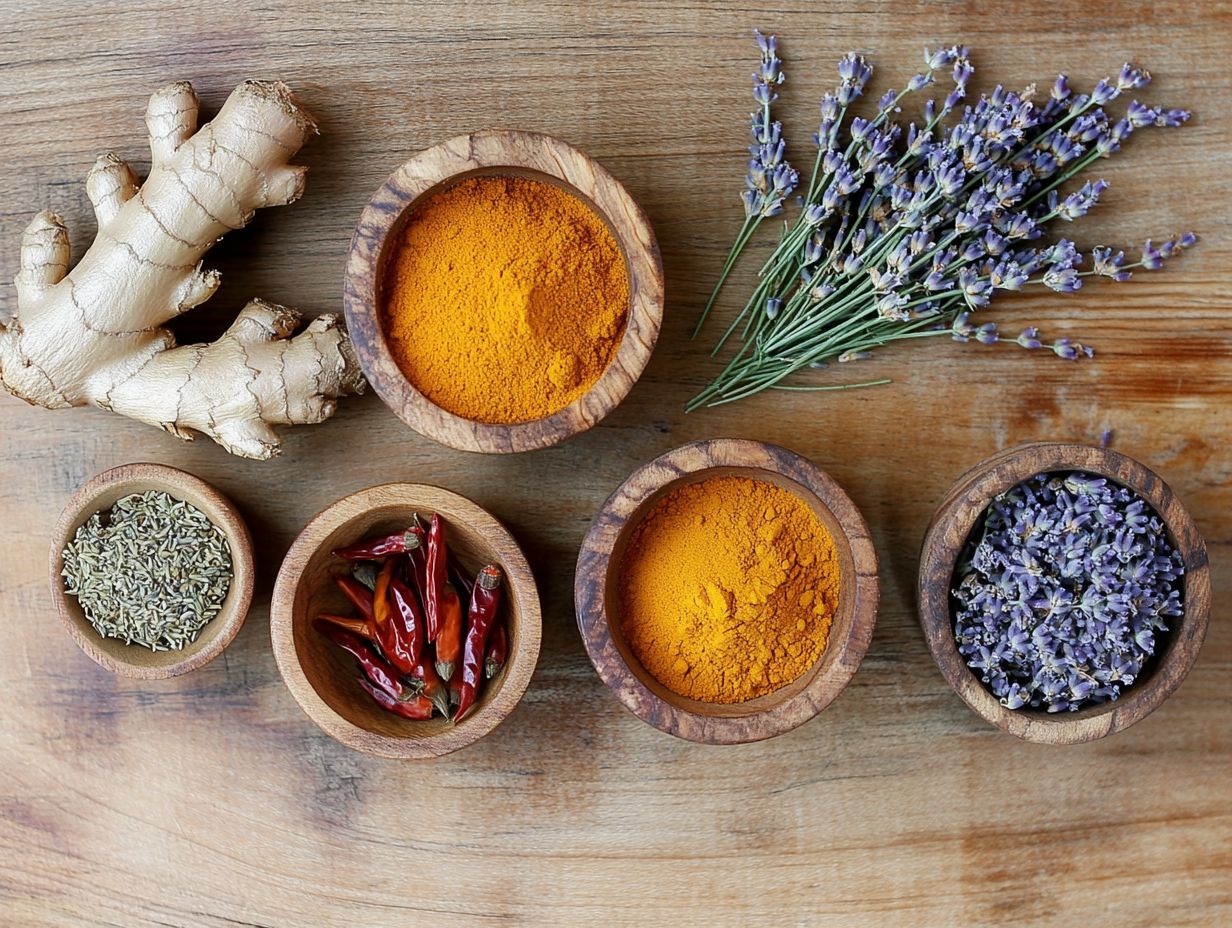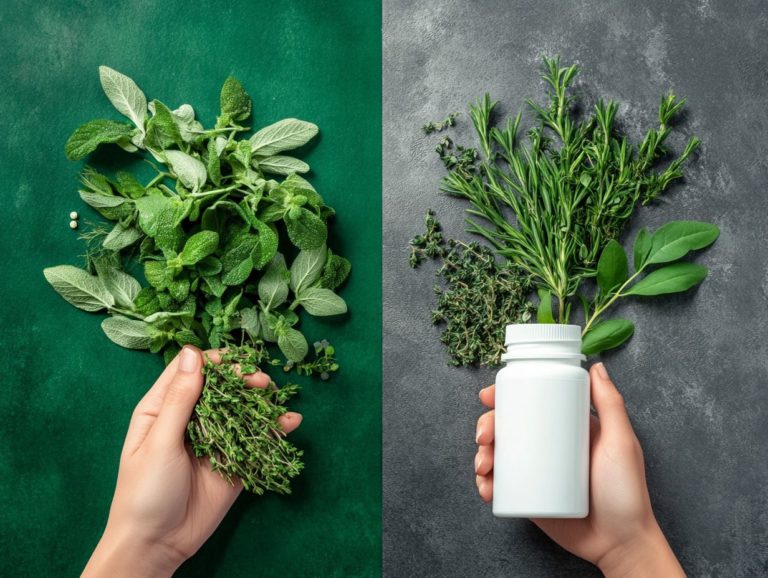5 Powerful Herbs for Pain Relief
Struggling with pain? Nature has some amazing allies to help you feel better! This article delves into five potent herbs turmeric, ginger, willow bark, cloves, and boswellia that have been revered for their pain-relieving capabilities. You ll learn how these herbs work, the different forms they come in, potential side effects to keep in mind, and simple ways to weave them into your daily routine.
The article also covers other natural remedies to help manage pain. Dive into this exploration and discover how these herbal wonders can transform your well-being!
Contents
Key Takeaways:

1. Turmeric
Turmeric is well-known for its potential medicinal benefits. Its active compound, curcumin, is particularly noted for natural pain relief. If you re grappling with long-lasting pain or inflammation from conditions like arthritis or nerve damage, turmeric might just be the answer you ve been seeking.
Curcumin is celebrated for its remarkable anti-inflammatory properties. It inhibits the activity of enzymes and cytokines that promote inflammation, making it a powerful ally in your wellness journey.
Clinical trials have showcased its effectiveness in alleviating symptoms of inflammatory diseases. This presents a compelling alternative to conventional anti-inflammatory medications that often come with unwelcome side effects like gastrointestinal distress and cardiovascular risks.
Historically, turmeric has been a cornerstone of Ayurvedic practices, valued not just for its culinary applications but also for its therapeutic benefits. For centuries, it has been employed to help balance bodily systems and enhance overall well-being.
The growing synergy of incorporating turmeric into your diet, paired with its clinical validation, increasingly positions it as a natural supplement worth considering for anyone looking to embrace holistic methods for managing inflammation.
2. Ginger
Ginger, that versatile root you might savor as ginger tea, is renowned for its natural pain relief properties. It’s particularly effective in managing long-lasting pain and inflammation, making it a go-to choice for those seeking herbal remedies for muscle pain and various health concerns.
This remarkable root is packed with active compounds like gingerols and shogaols. These compounds have been shown to inhibit inflammatory pathways, significantly reducing swelling and pain across a range of conditions.
These compounds work by blocking certain enzymes that promote inflammation, providing much-needed relief for anyone grappling with arthritis or muscle soreness. Incorporating ginger into your daily routine is refreshingly simple.
You can add fresh ginger slices to your smoothies, sprinkle ginger powder into your baked goods, or indulge in a soothing cup of warm ginger tea. This not only creates delightful flavors but also fosters healthful habits.
Typical dosages range from 1 to 3 grams per day, depending on your individual tolerance, making ginger a flexible and accessible option for enhancing your overall wellness.
Try adding these powerful herbs to your meals or supplements today and feel the difference!
3. Willow Bark
White Willow Bark, often celebrated as nature’s aspirin, offers remarkable benefits for chronic pain relief, especially in cases of arthritis and back pain. Its natural anti-inflammatory properties and rich history in traditional medicine make it a compelling choice.
This extraordinary plant is packed with active compounds like salicin, which your body converts into salicylic acid the cornerstone of its pain-relieving power. Many health professionals find intriguing parallels between these natural elements and the synthetic alternatives available in over-the-counter medications.
Unlike pharmaceutical options, White Willow Bark typically comes with fewer side effects, making it an appealing choice for those who prefer a holistic approach.
Experts recommend adding it to your daily health routine one that harmonizes with dietary and lifestyle changes to amplify its benefits. This way, you can explore a sustainable, nature-based treatment uniquely tailored to your individual needs while navigating chronic pain challenges.
4. Cloves

Cloves, renowned for their potent essential oils, offer impressive anti-inflammatory and analgesic properties. They serve as a valuable natural remedy for various types of pain relief, including nerve pain and musculoskeletal tension.
The key players behind these health benefits are eugenol and beta-caryophyllene, which have shown a remarkable ability to reduce swelling and alleviate discomfort. Clove oil, extracted from these aromatic buds, can be applied topically or used in aromatherapy, providing a soothing alternative to conventional medications.
In contrast to over-the-counter anti-inflammatory drugs, cloves present a holistic approach, often sidestepping the side effects of pharmaceutical options.
As you explore more natural alternatives for pain management, understanding the benefits of cloves can empower you to enhance your wellness routine.
5. Boswellia
Boswellia, an esteemed ingredient in Ayurvedic medicine, is celebrated for its remarkable anti-inflammatory properties, which can ease chronic pain conditions. It offers a compelling herbal alternative to conventional anti-inflammatory medications.
This ancient resin, sourced from the Boswellia serrata tree, influences key biochemical pathways by inhibiting the production of inflammatory substances, reducing inflammation at its source. Numerous clinical trials have underscored its efficacy, particularly in managing arthritis and inflammatory bowel diseases.
Historically, Ayurvedic practitioners have harnessed Boswellia for pain relief and to bolster respiratory health. However, it’s essential to be mindful of potential interactions with medications, particularly blood thinners and nonsteroidal anti-inflammatory drugs (NSAIDs). Consulting with healthcare providers before incorporating Boswellia into your treatment regimen is wise to ensure safety and effectiveness.
What Are the Benefits of Using Herbs for Pain Relief?
The benefits of using herbs for pain relief extend beyond managing symptoms. They can enhance your overall quality of life by addressing chronic pain and inflammation while reducing dependency on pharmaceutical drugs, as many health professionals in alternative medicine attest.
Incorporating specific herbs like turmeric, ginger, and willow bark can significantly contribute to your holistic well-being. Research shows that curcumin, the active compound in turmeric, effectively modulates inflammatory pathways, helping to reduce pain and improve mobility. Ginger has also been clinically proven to alleviate discomfort, particularly in musculoskeletal conditions.
This herbal approach encourages a lifestyle that prioritizes nutrition, physical activity, and mindfulness, enabling you to rely on natural remedies while adopting healthier habits.
By approaching pain relief from a multidimensional perspective, these herbal options become complementary tools in a broader strategy for enhancing your quality of life.
Explore the powerful benefits of these herbs today and consider how they can fit into your wellness journey!
What Are the Different Forms of These Herbs?
Herbs can be utilized in a variety of forms, including oral herbal therapies, essential oils, and infusions like ginger tea. This allows you to choose the methods that align with your preferences and therapeutic needs.
Each method has unique advantages for alleviating discomfort. It is essential to understand their distinct applications. For instance, essential oils offer a potent, concentrated approach that can be applied topically or diffused for inhalation, targeting localized pain with impressive speed.
In contrast, herbal teas provide a gentler effect, fostering overall relaxation and wellness through the comforting ritual of brewing.
When sourcing quality medicinal plants, seek out reputable suppliers or local herbalists. This ensures that the herbs are sustainably harvested and free from contaminants, thereby enhancing their therapeutic benefits for you.
How Do These Herbs Work to Relieve Pain?

The mechanisms through which herbs relieve pain involve intricate interactions that target inflammation and modulate your immune system. This makes them effective natural agents for managing chronic pain conditions.
Take curcumin, for example, the standout compound in turmeric. It has been shown to inhibit the production of prostaglandins, which are chemicals in the body that cause pain and inflammation. This inhibition is crucial, as it addresses the underlying causes of your discomfort.
Clinical trials show that curcumin can significantly reduce pain and enhance function for individuals dealing with conditions like osteoarthritis and rheumatoid arthritis.
These findings underscore the potential of herbal remedies. They not only alleviate your symptoms but also engage specific biochemical pathways, offering a holistic approach to pain management that you may find beneficial.
What Are the Possible Side Effects of Using These Herbs?
While many herbs are celebrated for their pain-relieving properties, it s crucial to weigh the potential side effects and interactions with medications before adding them to your pain management routine. Be sure to consult a healthcare provider before you start using these herbs!
Without a thorough personal assessment, you could unintentionally encounter adverse reactions. These may include gastrointestinal disturbances, allergic responses, or even worsened pain symptoms.
Take turmeric, for example. While it s hailed for its anti-inflammatory benefits, it might leave some feeling nauseous or with an upset stomach. Likewise, garlic, known for its blood-thinning effects, can increase bleeding risk, especially for those on anticoagulant medications.
Thus, it s essential for you to have an open dialogue about your health history and current medications with your healthcare provider. This proactive approach helps mitigate risks and ensures that your journey toward pain management is both effective and safe.
How Can These Herbs Be Incorporated into Daily Life?
Are you ready to discover how easy it is to add these powerful herbs to your life? You can easily add herbs to your daily routine!
Consider brewing a comforting cup of ginger tea, indulging in the soothing aromas of essential oils, or enhancing your meals with a dash of turmeric. These approaches promote a lifestyle grounded in holistic well-being and natural remedies for pain relief.
For a delightful ginger tea, steep fresh ginger slices in hot water for about 10 minutes. Enjoying this first thing in the morning can be a wonderful way to kickstart your digestion.
Turmeric can also easily find its way into your breakfast whether sprinkled into scrambled eggs or blended into a smoothie. Just remember to add a pinch of black pepper to boost absorption.
Embrace essential oils like lavender for a calming evening ritual that encourages relaxation before bedtime. Integrating these herbs into your routine not only elevates flavor but also brings a wealth of health benefits. This makes them essential components of a balanced and proactive lifestyle.
What Are Some Other Natural Remedies for Pain Relief?
You have a range of natural remedies for pain relief. These include herbal treatments, acupuncture, heat therapy, and cold therapy.
Each method has distinct benefits and effectiveness. For example, acupuncture involves inserting fine needles into specific points on the body to relieve pain. It’s been shown to reduce inflammation and enhance overall well-being, with clinical studies backing its ability to alleviate symptoms for many chronic pain sufferers.
Heat therapy boosts blood flow and relaxes stiff muscles, earning rave reviews from individuals grappling with conditions like arthritis.
On the flip side, cold therapy offers numbing effects that help reduce swelling and pain after injuries.
By weaving these remedies into your treatment plan, you might discover a more holistic approach to pain management, one that is bolstered by both personal experiences and scientific research!
Frequently Asked Questions

What are the 5 powerful herbs for pain relief?
The 5 powerful herbs for pain relief are turmeric, ginger, white willow bark, devil’s claw, and boswellia.
How does turmeric help with pain relief?
Turmeric contains curcumin, a compound with anti-inflammatory properties that can help reduce pain and swelling in the body.
Is ginger effective for pain relief?
Yes, ginger has been used for centuries as a natural remedy for pain and inflammation. It contains compounds that have analgesic and anti-inflammatory properties.
What is the benefit of using white willow bark for pain relief?
White willow bark contains salicin, a compound similar to aspirin that can help alleviate pain and inflammation in the body.
Can devil’s claw help with chronic pain?
Yes, devil’s claw has been traditionally used to treat chronic pain conditions such as arthritis and back pain. It contains anti-inflammatory compounds that can help reduce pain and improve mobility.
How does boswellia help with pain relief?
Boswellia contains boswellic acids, which have been shown to have anti-inflammatory and analgesic effects. It can help alleviate pain and stiffness in conditions such as osteoarthritis and rheumatoid arthritis.
Explore these remedies further, and consider consulting with a healthcare provider for personalized advice!






